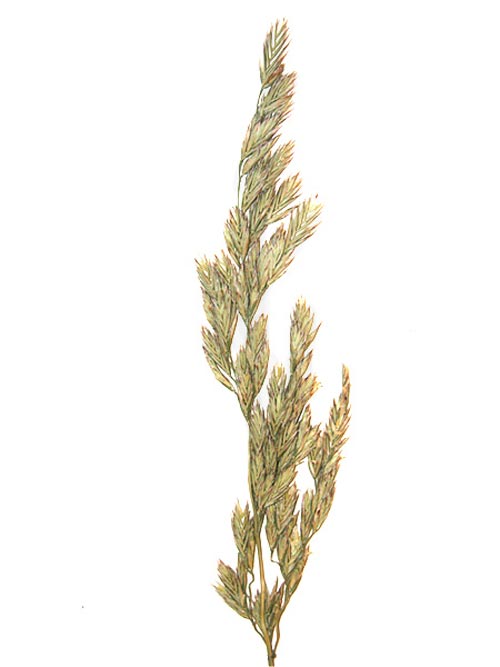Crops
Festuca arundinacea Schreb. - Tall fescue.
Taxonomic position.
Family Poaceae Barnhart., genus Festuca L.Synonyms.
Festuca elatior L., Festuca elatior subsp. arundinacea (Schreb.) Hack.Biology and morphology.
Chromosome number: 2n = 28, 42, 70. Perennial plant, very robust, hairless (except auricles), cespitous to a rather rhizomatous. Stems erect, 100-160 cm high. Blade rolled when young, large (3 - 10 mm), flat, strongly veined, coarse, rough on the upper side, shiny below, dark green. Sheaths of the inferior leaves purple-red. Ligule short, greenish. Auricles strong, ciliate. Panicle-like inflorescence 18-24 cm, spreading even after flowering, oblong, loose. Spikelets 4-7 flowered, briefly aristate, 10 - 15 mm long. The weight of 1000 seeds is 2,2 to 2,4 g. Blossoms in June, seed maturity can be expected during July-August. Cross-pollinated by wind.Distribution.
Introduced into culture since the beginning of XX century. Cultivated on relatively small squares in the forest, steppe and mountain areas at 72 regions and republics of former USSR countries. 10 breeding cultivars have the state permission for utilization.Ecology.
Mesophyte. Not resistant to drought. This grass is able to withstand ponding for up to three months, and is tolerant of waterlogged soils. Very good resistance to climate extremes (heat and cold). Resistant to late spring frosts (-4..-6°C) and to early autumn frosts (-5..-6°C). Large range of soil humidity. Tolerates remarkably well a sodden soil in winter. Optimum on cool soils, normally drained to dry. Very well adapted to alternations of the water supply regime. Large range for nutrient availability but excluded from very poor soils. Widely encountered on slightly acid to alkaline soils. Often on heavy clay soils or on deep loam but quite indifferent to the soil texture.Utilization and economic value.
Valuable component of grasses mixtures for cultural long-lived pastures. Combines well with clovers and alfalfa. Used for hay, haylage, silage. Regrows in the end of April and that.s why it is good for grazing in the first part of May or for early harvest. When harvested at the early heading stage, its nutritive value is comparable to that of other forage grasses. Later it is characterized by bad palatability by all domestic animals because of rough leaves and presense of alkaloids. Used in pasture mixtures on wetlands and for erosion control in humid northern regions. Improves soils structure and fertilization. Forage mass productivity ranges from 20-38 MT/ha, hay productivity ranges 5,4-9,2 MT/ha and seed productivity is 250-500 kg/ha.Literature:
Catalog of state permitted cultivars of agricultural crops. 1969. - M.: Kolos, 489 pp. (in Russian).Catalog of state permitted cultivars of agricultural crops. 1971. - M.: Kolos, 488 pp. (in Russian).
Catalog of state permitted cultivars of agricultural crops. 1974. - M.: Kolos, 480 pp. (in Russian).
Catalog of state permitted cultivars of agricultural crops. 1985. - M.: Kolos, Vol 3. - 489 pp. (in Russian).
Catalog of agricultural crops. cultivars permitted in Byelorussia. 1985. - Minsk: Uradjai, 176 pp. (in Russian).
Golovkin B. N. 1988. Cultigenic plant area. - M.: Nauka, 184 pp. (in Russian).
Medvedev P. F., Smetannikova A. I. The forage crops of European part of the USSR. 1981. - L.: Kolos, 336 pp. (in Russian).
Shashko D. N. Agroclimatic region of the USSR. 1967. - M.: Kolos, 335 pp. (in Russian).
Shashko D. N. Agroclimatic resources of the USSR. 1985. - M.: Kolos, 248 pp. (in Russian).
Soil resources of the USSR (Agricultural regions of areas and republics of USSR). 1990. - M.: - Vol 1. - 260 pp. (in Russian).
State register of Ukrainian plant cultivars. 1992. - Kiev: Urojai, 199 pp. (in Russian).
State register of breeding achievements permitted for utilization. Plant cultivars. 1994. - M.: - 218 pp. (in Russian).
State register of breeding achievements permitted for utilization. Plant cultivars. 1996. - M.: - 171 pp. (in Russian).
State register of breeding achievements permitted for utilization. Plant cultivars. 1999. - M.: - 192 pp. (in Russian).
State register of breeding achievements permitted for utilization. Plant cultivars. 2000. - M.: - 232 pp. (in Russian).
State register of breeding achievements permitted for utilization. Plant cultivars. 2001. - M.: - 252 pp. (in Russian).
State register of breeding achievements permitted for utilization. Plant cultivars. 2003. - M.: - 236 pp. (in Russian).
The Natural-agricultural regions and utilization of soil resources of the USSR. A. N. Kashtanov (ed.). 1983. - M.: Kolos, 336 pp. (in Russian).
The register of plant cultivars in Ukraine. 1996. - Kiev: Urojai, 259 pp. (in Russian).


